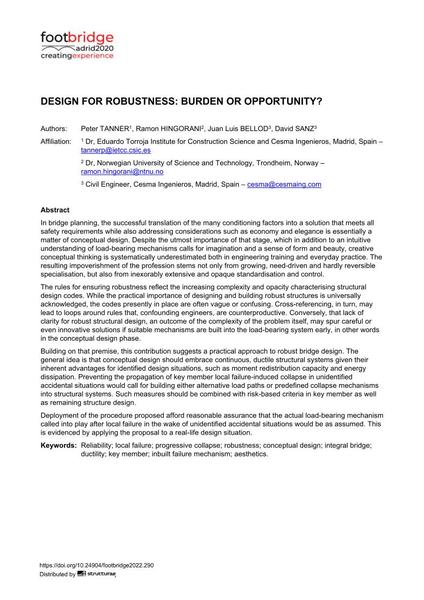Design for Robustness: Burden or Opportunity?

| Author(s): |
Peter Tanner
(Dr, Eduardo Torroja Institute for Construction Science and Cesma Ingenieros, Madrid, Spain)
Ramón Hingorani (Dr, Norwegian University of Science and Technology, Trondheim, Norway) Juan Luis Bellod (Civil Engineer, Cesma Ingenieros, Madrid, Spain) David Sanz (Civil Engineer, Cesma Ingenieros, Madrid, Spain) |
|---|---|
| Medium: | conference paper |
| Language(s): | English |
| Conference: | Footbridge 2022: Creating Experience, Madrid, Spain, 07-09 September 2022 |
| Published in: | Footbridge Madrid 2022 - Creating Experience |
| DOI: | 10.24904/footbridge2022.290 |
| Abstract: |
Since the successful translation of many constraints into an aesthetically appealing as well as reliable, functional and cost-effective structure is primarily a question of sound conceptual design, the importance of this step in the design process as a whole cannot be overstated. Nonetheless, the growing complexity of analysis and verification methods, materials technology and construction procedures is driving ever greater specialisation against a backdrop of increasingly extensive and opaque standardisation and control systems. Such specialisation comes at the expense of conceptual design training in engineering schools and consequently of structural engineers’ creativity and other skills necessary to create compelling designs for structures. The rules for ensuring robustness reflect the increasing complexity and opacity characterising structural design codes. While the practical importance of designing and building robust structures is universally acknowledged, the codes presently in place are often vague or confusing. Cross-referencing, in turn, may lead to loops around rules that, confounding engineers, are counterproductive. At the same time, however, that lack of clarity may afford opportunities for innovative solutions by building items that ensure robustness into the conceptual design of a structure. This paper proposes an operational design process that deals appropriately with all factors of structural performance, including robustness, without compromising bridge economy or elegance. That process, which combines several robustness strategies, including risk- based considerations, is illustrated with a case study. |
| Keywords: |
aesthetics ductility robustness progressive collapse reliability conceptual design integral bridge local failure key member inbuilt failure mechanism
|
| License: | This creative work is copyrighted. The copyright holder(s) do(es) not grant any usage rights other than viewing and downloading the work for personal use. Further copying or publication requires the permission of the copyright holder(s). |
Structures and Projects
0.07 MB Download full text file (PDF)
0.46 MB
- About this
data sheet - Reference-ID
10667763 - Published on:
30/05/2022 - Last updated on:
01/06/2022



